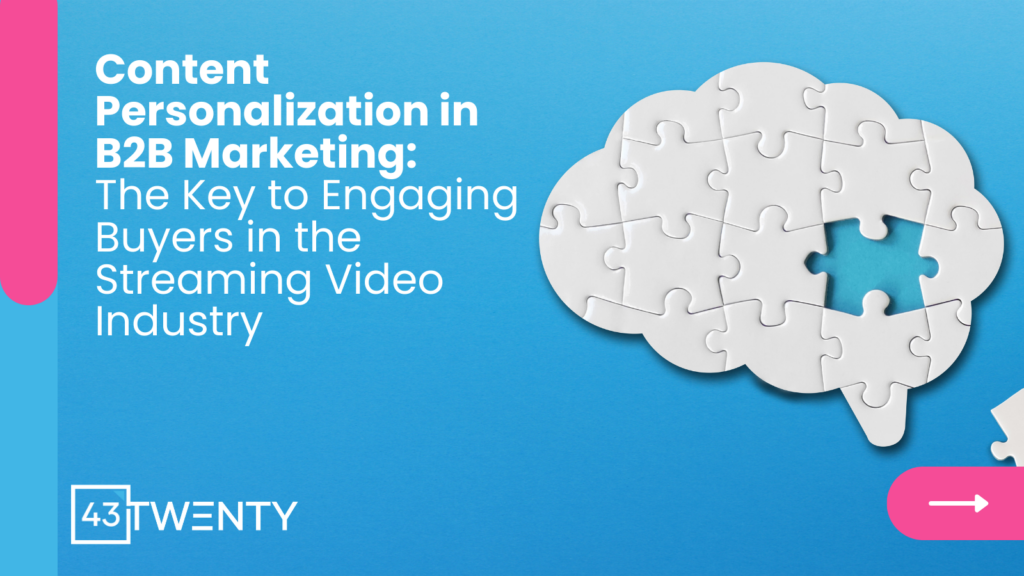
Today, buyers are becoming more discerning and demanding. It means businesses must adapt and provide a more personalized customer experience to remain competitive. Content personalization has become the holy grail of marketing, especially in the B2B space. By creating tailored content, marketers can increase engagement and awareness and boost their bottom line.
However, despite the promise of personalization, many B2B organizations still need help to implement it effectively. Challenges such as data management and technology integration can pose obstacles. So why is content personalization essential in B2B marketing, and how can it enhance your customers’ experience with your brand?
What is Content Personalization?
We work primarily with B2B companies in the streaming video space. When we think of personalization, we think of creating different types of content designed for various individuals within an organization.
People in different roles or with different interests and expertise might need content that speaks to their unique needs and preferences. For instance, technical folks like a CTO might want content with technical details and terms. Whereas mentioning terms like “edge scale” or “no code” might fly over non-technical decision-makers like the CEO’s head. In that case, you’ll want to keep explanations simple and insights relevant to their strategic perspective.
In my approach to explaining technical topics to non-technical people, I often find inspiration in the curiosity of a three-year-old who incessantly asks “why.” This method guides me to break down intricate ideas by repeatedly questioning, “Why (does this matter)?” By doing so about three times, I always uncover compelling reasons that even non-technical individuals should genuinely care about the subject. You should give it a try.
Personalizing content ensures that everybody gets the information they need and can understand, making your communication more effective and relevant to everyone in the organization.
By investing effort into personalizing your content, you not only deliver meaningful value to your audience but also showcase your understanding of their particular demands and challenges. This can heighten your content’s engagement levels and fortify connections with your brand.
Understand Your Audience
Personalizing your content begins with understanding who your audience is. One effective way to do this is by creating buyer personas. Buyer personas are semi-fictional representations of your ideal customers. They are based on market research and actual data about your existing customers and can include details such as job role, industry, company size, challenges, and goals.
Creating personas involves conducting thorough research, surveying your existing customer base, and aligning with your sales team to leverage their direct insights. Once you have developed these personas, you can create personalized content that speaks directly to their needs and concerns.
For instance, if one of your personas is a CTO of a Tier 2 media company, your content might focus on how your products or services can help resolve technical issues or enhance their tech stack. On the other hand, if your persona is a CEO of the same company, you might create content that addresses business growth and strategic decision-making.
In my approach to explaining technical topics to non-technical people, I often find inspiration in the curiosity of a three-year-old who incessantly asks “why.” This method guides me to break down intricate ideas by repeatedly questioning, “Why (does this matter)?” By doing so about three times, I always uncover compelling reasons that even non-technical individuals should genuinely care about the subject. You should give it a try.
By segmenting your audience this way and creating content that resonates with each group, you’re more likely to engage your audience, meet their needs, and ultimately drive them to action.
Need help creating buyer personas? We can help.
Personalize the Content Delivery
Creating personalized content is just the first step. How you deliver that content also plays a crucial role in engaging your audience effectively. Tailoring how you present your content can significantly impact capturing your audience’s attention and keeping them engaged.
One approach to personalized content delivery is timing. Consider when your target personas will most likely be active and receptive to your content. For example, if your audience includes busy executives, sending content during their morning commute or lunch break might be more effective than late at night.
Another aspect of content delivery to personalize is the format. Different people prefer consuming content in various ways. Some might enjoy reading articles, while others prefer watching videos or podcasts. By offering your content in different formats, you accommodate diverse preferences and make engaging your audience with your message easier.
Personalizing content delivery also involves considering the platform. Different personas might frequent various platforms, such as social media (Linkedin, Twitter), industry forums or groups, or email. Understanding where your audience spends their time allows you to share your content where they’re most likely to see it.
Moreover, adapting your content’s tone and style to match each persona’s preferences can enhance engagement. While some personas might appreciate a formal and informative tone, others respond better to a more conversational and relatable approach.
Incorporating personalization into content delivery requires ongoing assessment and adjustment. Analyze metrics such as click-through rates, open rates, and engagement levels to determine what’s resonating with different segments of your audience. This data-driven approach allows you to refine your content delivery strategies and continually improve the impact of your personalized content.
You demonstrate a deep understanding of your audience’s preferences and habits by customizing your content delivery’s timing, format, platform, and tone. This level of consideration enhances engagement and fosters a stronger connection between your brand and your audience, leading to more meaningful interactions and successful outcomes.
TLDR
By taking the time to personalize your content and its delivery, you provide a more valuable experience for your audience. You connect with them on a deeper level, meet their needs, and strengthen your relationship with them. Personalizing engagement is a powerful tool that improves visibility and intensifies customer loyalty and trust. Investing in personalization can help build a lasting bond between your brand and your target personas.